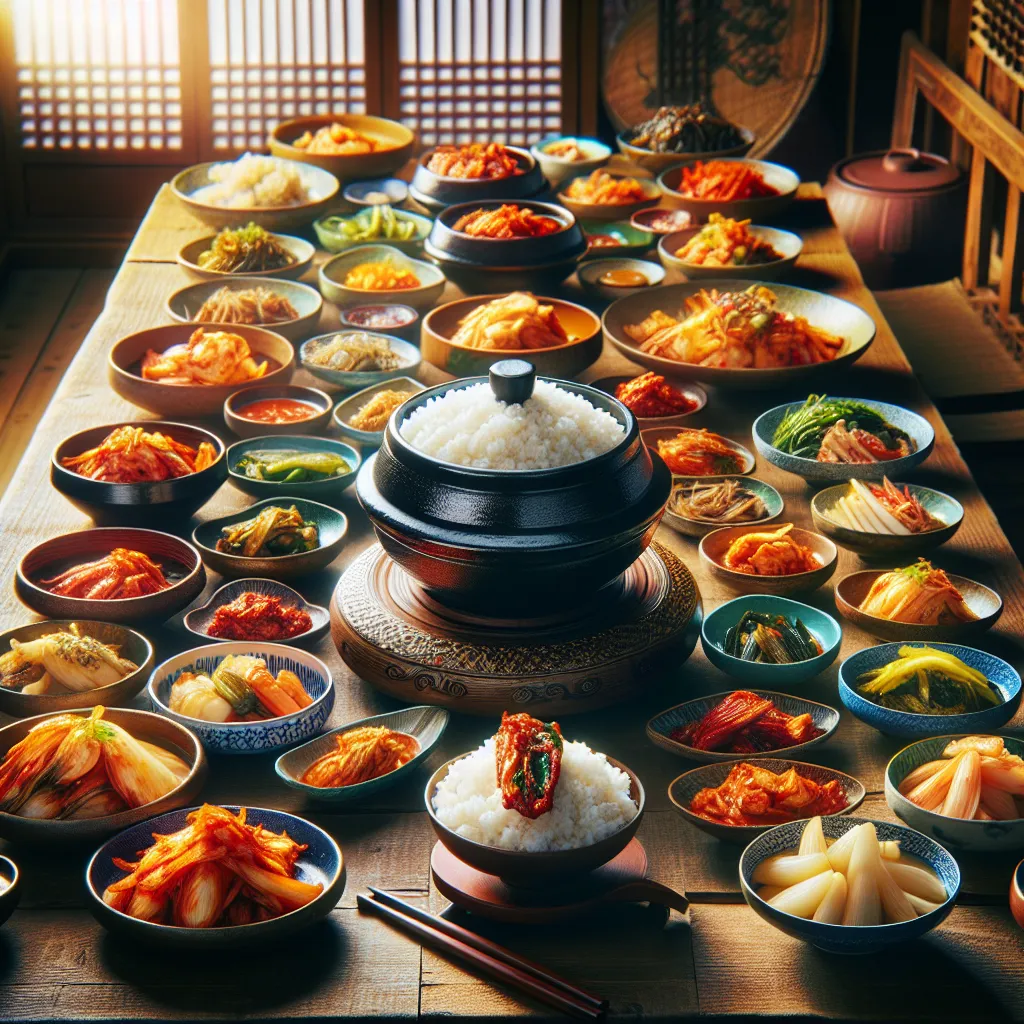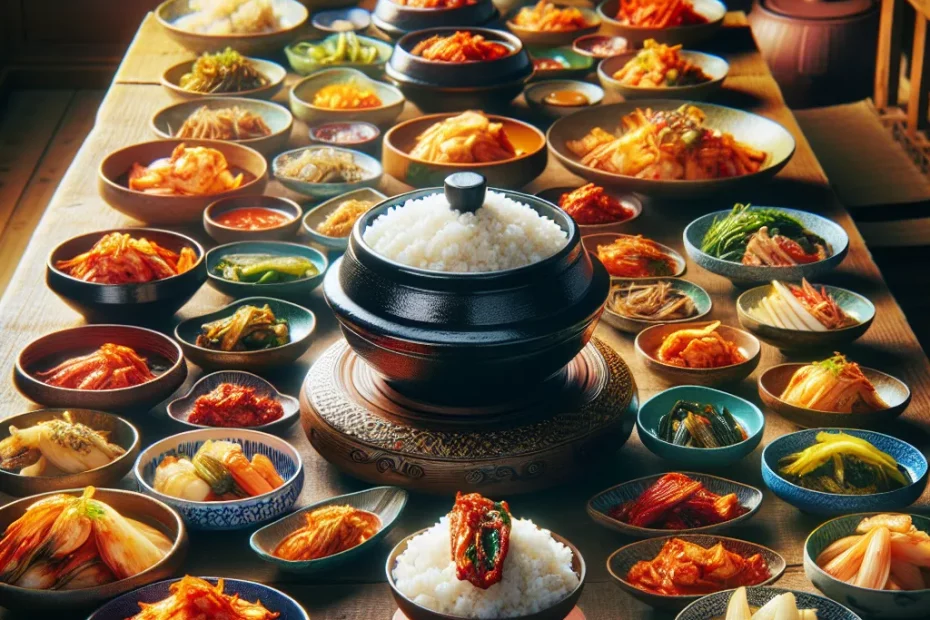In Korean cuisine, rice holds a special place as a staple food that has been cherished for centuries. Its significance goes beyond mere sustenance, as it plays a crucial role in shaping the cultural identity of the Korean people. The love for rice in Korean diet is deeply rooted in tradition and history, reflecting not just a dietary preference but a way of life. As we delve into the historical, nutritional, and culinary aspects of rice in Korean culture, we begin to appreciate the profound impact this humble grain has had on shaping the culinary landscape of Korea. Let us explore the multifaceted relationship between Koreans and rice, and unravel the rich tapestry of flavors and traditions that make it an indispensable part of Korean gastronomy.

Rice in Korean Cuisine
In Korean cuisine, rice holds a position of utmost importance, serving as the staple food that accompanies almost every meal. 🍚 Known as “bap” in Korean, rice plays a crucial role in shaping the culinary identity of Korea. With a long history deeply rooted in the Korean culture, rice is not just a source of sustenance but a symbol of tradition and heritage. 🌾
The Art of Rice Preparation
Koreans have a deep appreciation for the quality of rice, with various types such as short-grain, medium-grain, and long-grain rice being cultivated and consumed. 🌾 The meticulous process of washing, soaking, and cooking rice is considered an art form in itself, reflecting the meticulous nature of Korean cuisine. The texture and flavor of perfectly cooked rice are essential in achieving harmony with the diverse side dishes that make up a traditional Korean meal. 🍚🥢
Iconic Dish: Bibimbap
One of the most iconic Korean dishes, bibimbap, showcases the versatility of rice in Korean cuisine. This colorful dish features a bed of steamed rice topped with an array of vegetables, meat, and a fried egg, all beautifully arranged in a bowl. The combination of flavors and textures, along with the gochujang (red chili paste) sauce, creates a harmonious blend that tantalizes the taste buds. 🍲🌶️
Cultural Significance
Rice is not only a staple in everyday meals but also holds cultural significance in Korean rituals and celebrations. From ancestral rites to festive occasions, rice plays a central role in traditional ceremonies, symbolizing abundance, prosperity, and unity. 🎉🌾
Modern Innovations
In modern Korean cuisine, rice continues to evolve, with innovative dishes and fusion recipes incorporating rice in creative ways. From rice cakes to rice porridge, the versatility of rice in Korean cooking knows no bounds. 🍡🥣
Overall, the love for rice in Korean cuisine goes beyond mere sustenance; it embodies a deep-rooted connection to tradition, culture, and identity. With each grain symbolizing a rich history and a vibrant culinary heritage, rice remains at the heart of Korean gastronomy, captivating taste buds and hearts alike. 🇰🇷🍚
Health Benefits of Rice
Rice stands as a staple that not only satisfies our taste buds but also nourishes our bodies with a plethora of health benefits! 🌾
The Nutritional Powerhouse
Rice, particularly brown rice, is a powerhouse of nutrients, boasting high levels of fiber, vitamins, and minerals essential for our overall well-being. 🍚 Its low glycemic index makes it a fantastic source of sustained energy, perfect for fueling our daily activities without causing drastic spikes in blood sugar levels. 💪
Gluten-Free and Digestible
Rice is a gluten-free grain, making it an ideal choice for individuals with gluten sensitivities or celiac disease. 🌾 It is easily digestible, gentle on the stomach, and serves as a blank canvas for a variety of culinary creations around the world. 🌏
Rich in Micronutrients
When it comes to micronutrients, rice is rich in manganese, selenium, and magnesium, all of which play crucial roles in supporting our immune system, regulating blood sugar levels, and promoting optimal nerve and muscle function. 💊 Additionally, the antioxidants found in rice help combat oxidative stress and reduce the risk of chronic diseases. 🍚
Promoting Gut Health
The resistant starch in rice acts as a prebiotic, feeding the beneficial bacteria in our gut and contributing to a healthy digestive system. 🦠 A happy gut means better nutrient absorption and a stronger immune response. 🌟
In conclusion, rice is not just a humble grain on our plates; it is a nutritional powerhouse that offers a multitude of health benefits. From providing sustained energy to supporting immune function and gut health, rice truly deserves its special place in the diverse tapestry of the human diet. 🌾 Let’s celebrate the love for rice and savor its goodness with every delicious bite! 🍚
Different Types of Rice Used in Korean Cooking
Rice holds a special place in Korean cuisine, serving as the staple food that accompanies almost every meal. In Korean culture, rice is not just a side dish but the very essence of a satisfying meal. When it comes to Korean cooking, various types of rice are utilized, each with its unique characteristics and flavors that contribute to the diverse and rich culinary landscape of Korea. 🍚🇰🇷
Short-Grain White Rice (“Mepssal”)
One of the most commonly used types of rice in Korean cooking is short-grain white rice, known as “mepssal” in Korean. This type of rice is sticky when cooked, making it perfect for dishes like bibimbap and kimbap. Its slightly sweet flavor and soft texture make it a favorite among Koreans for everyday meals. Whether steamed or fried, short-grain white rice adds a comforting element to any dish.
Brown Rice (“Hyeonmi”)
Another popular variety is brown rice, or “hyeonmi” in Korean, which is known for its nutty flavor and chewy texture. Brown rice is considered a healthier alternative to white rice due to its higher fiber content and essential nutrients. It is often used in traditional Korean porridges like “juk” and as a base for rice bowls topped with various vegetables and proteins. The earthy taste of brown rice adds depth to dishes and provides a wholesome dining experience.
Glutinous Rice (“Chapssal”)
In addition to white and brown rice, Korean cuisine also features glutinous rice, or “chapssal.” This type of rice has a higher starch content, giving it a sticky and chewy texture when cooked. Glutinous rice is commonly used in making rice cakes, traditional desserts like “songpyeon,” and alcoholic beverages such as rice wine. Its unique texture and ability to bind ingredients together make it a versatile ingredient in Korean cooking.
Black Rice (“Heungmi”)
Furthermore, black rice, known as “heungmi,” is gaining popularity in modern Korean cuisine for its striking color and nutty flavor. Black rice is rich in antioxidants and nutrients, making it a nutritious choice for health-conscious individuals. In Korean cuisine, black rice is often used in salads, rice bowls, and even desserts to add visual appeal and a distinct taste profile. Its bold appearance and unique taste make it a standout ingredient in contemporary Korean dishes.
In conclusion, the variety of rice used in Korean cooking reflects the diversity and depth of Korean cuisine. From sticky white rice to nutty brown rice, each type brings its own character and enhances the flavors of traditional and modern Korean dishes. Understanding the different types of rice and their culinary applications is essential for appreciating the essence of Korean food culture. So, the next time you enjoy a Korean meal, remember the role that rice plays in creating a truly satisfying dining experience! 🍚🇰🇷
Historical Significance of Rice in Korean Culture
Rice, known as “ssal” in Korean, holds a paramount significance in Korean culture, history, and cuisine. For centuries, rice has been the staple food in Korea, shaping not only the dietary habits but also the social and cultural aspects of the Korean society. 🌾
The Origins of Rice Cultivation in Korea
Rice cultivation in Korea dates back thousands of years, with historical records indicating that rice farming began as early as the Neolithic period. The introduction of wet rice cultivation techniques from China played a crucial role in the development of Korean agriculture, leading to the establishment of settled communities and the formation of early Korean states. 🌾🌾
Rice as a Symbol of Wealth and Prosperity
Throughout Korean history, rice has been more than just a source of sustenance; it has been a symbol of wealth, abundance, and prosperity. In ancient times, rice was used as a form of currency and tribute, highlighting its economic importance. The value of rice was so significant that it was often used to measure one’s social status and power in society. 🌾💰
The Symbolic Meaning of Rice in Korean Culture
Moreover, rice holds a symbolic meaning in Korean culture, representing fertility, life, and blessings. Traditional Korean rituals and ceremonies often include rice as a sacred offering to ancestors and spirits, emphasizing the spiritual connection between the people and the land. The annual “Dano” festival, a celebration of agriculture and nature, showcases the deep-rooted reverence for rice in Korean society. 🍚🎉
Rice in Korean Cuisine
In Korean cuisine, rice is the foundation of virtually every meal, served in various forms such as steamed rice, rice cakes, and rice porridge. The traditional Korean dining etiquette places great importance on rice, with proper manners dictating that one should not waste a single grain of rice, reflecting the value and respect accorded to this essential grain. 🍚🥢
Continuing Influence of Rice in Korean Culture
Today, rice continues to play a central role in Korean cuisine, with dishes like bibimbap, kimchi fried rice, and rice cakes remaining popular favorites among Koreans and international food enthusiasts alike. The enduring love for rice in Korean culture not only highlights its nutritional significance but also underscores its cultural and historical importance in shaping the identity of the Korean people. 🇰🇷🍚
In conclusion, the historical significance of rice in Korean culture cannot be overstated. From its role in shaping the agricultural practices and economy of ancient Korea to its symbolic importance in rituals and daily life, rice stands as a pillar of Korean identity and heritage. As the saying goes, “Bap is life,” emphasizing the inseparable connection between rice and Korean culture. 🌾🇰🇷
Rice has been an integral part of Korean cuisine for centuries, playing a crucial role in shaping the country’s culinary identity. Not only is rice a staple food in Korea, but it also holds significant cultural and historical importance. The diversity of rice varieties used in Korean cooking reflects the rich agricultural heritage of the country. Additionally, the health benefits associated with consuming rice further highlight its value in Korean diet. From providing essential nutrients to promoting digestive health, rice offers a range of advantages that contribute to overall well-being. Understanding the deep-rooted love and appreciation for rice in Korean culture sheds light on the profound connection between food, tradition, and identity. Embracing the essence of rice in Korean cuisine is not just about nourishment, but also about honoring a legacy of culinary excellence that continues to thrive in modern times.
